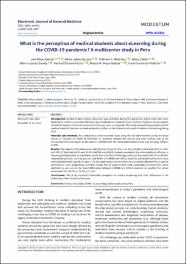“What is the perception of medical students about eLearning during the COVID-19 pandemic? A multicenter study in Peru“

Ver/
Descargar
(application/pdf: 535.7Kb)
(application/pdf: 535.7Kb)
Fecha
2022-07-13Autor(es)
Moya-Salazar, Jeel
Jaime-Quispe, Alexis
Milachay, Yeferson S.
Cañari, Betsy
Lozano-Zanely, Glenn
Chicoma-Flores, Karina
Moya-Salazar, Marcia M.
Contreras-Pulache, Hans
Metadatos
Mostrar el registro completo del ítemResumen
“Introduction: As face-to-face medical education was restricted during the pandemic; digital tools have been
deployed to continue education showing a good educational impact in most countries. However, the perception
of medical students in Peru on eLearning has not yet been investigated. This study assessed the perception of 440
medical students from two national universities in Peru on the characteristics and limitations of eLearning during
2021.
Materials and methods: We conducted a cross-sectional study using the self-administered survey Encuesta
Virtual en Tiempos de COVID-19 (EVI-CV19) on students between the second and sixth medical year of the
Universidad Nacional Mayor de San Marcos (UNMSM) and the Universidad Nacional San Luis Gonzaga (UNSLG,
n=325).
Results: The majority of students were under 30 years of age (93.9% vs. 97.2%, p=0.084), and female (67% vs. 64%,
p=0.107). Of the total, 63.9% and 81.5% UNMSM and UNSLG students considered the virtual platform effective in
favouring feedback with recorded lectures (85.2% vs. 85.5%) and the organization of documents (61.7% vs. 80.9%),
respectively (p>0.05). Seventy per cent and 46.8% of UNMSM and UNSLG students perceived that teachers were
nottrained (p=0.063), and 26.1% and17.2% of students perceived thatthe virtual modality affected their academic
performance a lot, respectively (p=0.003). About 38% of students from both universities perceived the virtual
platforms as very secure. We found differences between UNMSM and UNSLG students on whether the virtual
exams were fair (28.7% vs. 52.3%, p<0.001).
Conclusions: This study reported a favorable perception of medical eLearning with clear differences in the
limitations of the virtual environment.“
Colecciones
- SCOPUS [380]

